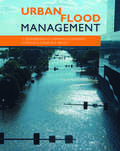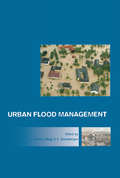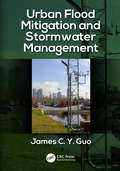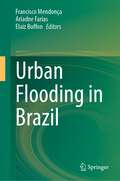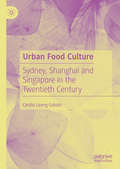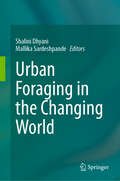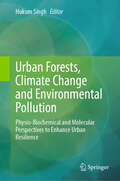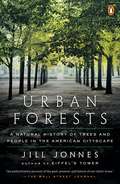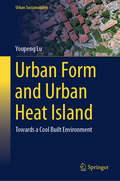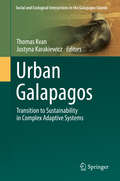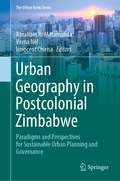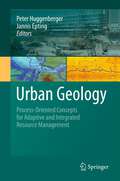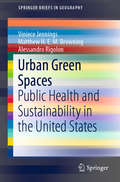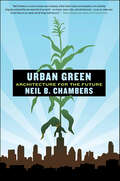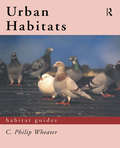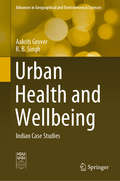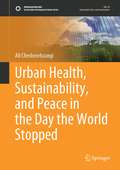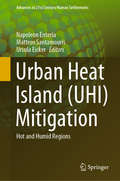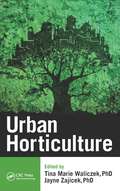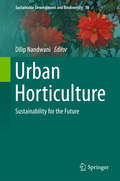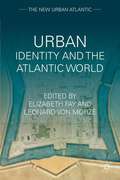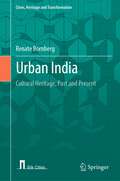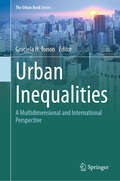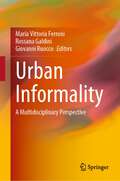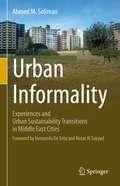- Table View
- List View
Urban Flood Management
by Chris Zevenbergen Adrian Cashman Niki Evelpidou Erik Pasche Stephen Garvin Richard AshleyAlong with windstorms, floods are the most common and widespread of all natural disasters. Although they can often be predicted, they cause loss of life, damage and destruction, as many urban communities are located near coasts and rivers. In terms of victims, floods are responsible for more than half the deaths caused by natural catastrophes. As f
Urban Flood Management: Introduction - 1st International Expert Meeting on Urban Flood Management
by Chris Zevenbergen Andras Szollosi-NagyOver the last decades the world has witnessed a growing number of floods in urban areas. Climate change and rapid urbanization will exacerbate this trend. Flooding incidents in urbanized catchments and low-lying areas, such as polders, can lead to great public concern and anxiety, and their economical impact is severe. Apart from well-known flood prevention strategies, new approaches to the accommodation of floods are needed to create robust and sustainable solutions that enable us to cope with the ever-increasing urban pressure on flood-prone areas and the uncertainties created by climate change. Urban Flood Management comprises a multidisciplinary survey of recent developments in this field. Subjects like spatial and urban planning, flood insurance, flood resilience, flood proofing techniques, risk perception and preparedness and flood forecasting are treated by authorities from Brazil, India, the USA and Europe. Urban Flood Management will provide anyone active in the fields of water, risk and urban management with the latest information and insights that were obtained with a global and multidisciplinary approach.
Urban Flood Mitigation and Stormwater Management
by James C GuoEffective urban drainage to manage stormwater and control flooding depends on good engineering, especially when an environmentally sustainable approach is being applied. This new text focuses on green methods and modelling techniques. It covers the principles of hydrology and drainage, low-impact-development (LID) designs, computer modelling techniques, the evaluation of existing systems, and planning for both new development and urban renewal. It outlines design procedures using examples, spreadsheet models, photos, and real-world design examples. Unlike other books, which focus on extreme events, this book covers hydrologic designs for both extreme and frequent events, and reflects the latest revolution in stormwater LID management, and takes a quantitative as well as a qualitative approach. PowerPoint® presentations and Excel® computer models are provided to follow and build on the exercises in the book. It is written especially for students on urban watershed courses, and also for those studying urban planning, landscaping, water resources, hydrology and hydraulics.
Urban Flooding in Brazil
by Francisco Mendonça Ariadne Farias Elaiz BuffonThis contributed volume analyzes flooding scenarios in Brazilian cities using a geographic and spatiotemporal approach to explore impacts and ways to mitigate future disasters. The problem of urban flooding is growing in Brazilian cities due to the increasing number of natural disasters in the context of global climate change; this is a topic that poses challenges to urban planners and academics. Through three sections, this volume offers theoretical-conceptual, methodological and technical case studies, as well as cases that explore urban socio-environmental problems associated with flooding. Throughout the book, the concepts of risk, vulnerability and adaptation are used to explore future flood scenarios in Brazil.The integrated vision offered in this volume covers the floods themselves, evaluation of flood impacts, and the management process before, during, and after the flood event. The case studies presented here elucidate the concept of comprehensive urban flood management, offering a technical and diagnostic basis for the problem in different cities in Brazil. The present and future challenges presented by these chapters offer widely-transferable lessons that can be applied to making cities around the world more sustainable and disaster-resilient.
Urban Food Culture: Sydney, Shanghai and Singapore in the Twentieth Century
by Cecilia Leong-SalobirThis book explores the food history of twentieth-century Sydney, Shanghai and Singapore within an Asian Pacific network of flux and flows. It engages with a range of historical perspectives on each city’s food and culinary histories, including colonial culinary legacies, restaurants, cafes, street food, market gardens, supermarkets and cookbooks, examining the exchange of goods and services and how the migration of people to the urban centres informed the social histories of the cities’ foodways in the contexts of culinary nationalism, ethnic identities and globalization. Considering the recent food history of the three cities and its complex narrative of empire, trade networks and migration patterns, this book discusses key aspects of each city’s cuisine in the twentieth century, examining the interwoven threads of colonialism and globalization.
Urban Foraging in the Changing World
by Shalini Dhyani Mallika SardeshpandeThis volume brings together theoretical, experiential, and creative perspectives on the phenomenon of urban foraging. In a rapidly urbanising world, foraging is (re)raining popularity as a way to connect with nature and cope with uncertainty. Authors from various disciplines and geographies make sense of what this means for humanity. Urban foraging represents a multifaceted movement that provides people with avenues for sustenance, socialising, and spirituality. Motivations and implications of urban foraging vary across the socioeconomic spectrum, as do barriers and enablers. Urban foraging can help people adapt to change, and build resilience to shocks, but its spontaneous and unregulated nature makes it attractive to many. Recognising and promoting sustainable urban foraging therefore is a delicate balancing act. This collection discusses the philosophical and practical considerations towards this aim. The book is of interest to researchers, practitioners, entrepreneurs, and creatives, inviting readers to envisage scenarios that are desirable and achievable. It is of special interest to those working in urban and landscape planning, social-ecological systems, non-government organisations, municipal and development corporations, and the environment.
Urban Forests, Climate Change and Environmental Pollution: Physio-Biochemical and Molecular Perspectives to Enhance Urban Resilience
by Hukum SinghThis book contributes significantly to the international literature by bringing forth a novel and comprehensive exploration of urban resilience in the face of climate change and environmental pollution. Its focus on integrating physiological, biochemical, and molecular dimensions distinguishes it from existing literature. The book offers several key contributions, including an interdisciplinary approach to understanding the complex interactions within urban ecosystems. It includes cutting-edge insights that have not been extensively explored in existing literature, practical applications, and evidence-based strategies to enhance urban sustainability and resilience. The book has a global relevance to a diverse international readership and provides strategic guidance to policymakers and urban planners when making decisions to develop evidence-based strategies that cater to the specific challenges of cities. Urban forests play a critical role in enhancing the resilience of cities by providing numerous benefits, including improved air quality, reduced urban heat island effect, and enhanced biodiversity, ultimately improving urban health. Besides, urban forests are a crucial natural-based solution (NbS) to mitigate air pollution and climate change impacts in cities. However, in the face of climate change and environmental pressures, urban forests face significant challenges to their survival and functionality. This book explores the complex morpho-physio-biochemical and molecular changes that enable urban forests to flourish amidst climate change and environmental pollution. It examines how urban trees modulate their morphological structures, including root systems and physiological and biochemical functioning, and molecular alterations to withstand changing urban climatic and environmental conditions.
Urban Forests: A Natural History of Trees and People in the American Cityscape
by Jill Jonnes"Far-ranging and deeply researched, Urban Forests reveals the beauty and significance of the trees around us." --Elizabeth Kolbert, Pulitzer Prize-winning author of The Sixth Extinction"A comprehensive look at the trees of American cities . . . this book deserves [great interest]; indeed, no one who has loved a single tree will be able to set it aside." --Kirkus ReviewsA celebration of urban trees and the Americans--presidents, plant explorers, visionaries, citizen activists, scientists, nurserymen, and tree nerds--whose arboreal passions have shaped and ornamented the nation's cities, from Jefferson's day to the present Nature's largest and longest-lived creations, trees play an extraordinarily important role in our cityscapes, living landmarks that define space, cool the air, soothe our psyches, and connect us to nature and our past. Today, four fifths of Americans live in or near cities, surrounded by millions of trees, urban forests containing hundreds of species. Despite the ubiquity and familiarity of those trees, most of us take them for granted and know little of their specific natural history or civic virtues. Jill Jonnes's Urban Forests is a passionate, wide-ranging, and fascinating natural history of the tree in American cities over the course of the past two centuries. Jonnes's survey ranges from early sponsors for the Urban Tree Movement to the fascinating stories of particular species (including Washington, DC's famed cherry trees, and the American chestnut and elm, and the diseases that almost destroyed them) to the institution of Arbor Day to the most recent generation of tree evangelists who are identifying the best species to populate our cities' leafy canopies. The book examines such questions as the character of American urban forests and the effect that tree-rich landscaping might have on commerce, crime, and human well-being. As we wrestle with how to repair the damage we have wrought on nature and how to slow climate change, urban forests offer an obvious, low-tech solution. (In 2006, U.S. Forest Service scientist Greg McPherson and his colleagues calculated that New York City's 592,000 street trees annually saved $28 million in energy costs through shading and cooling, or $47.63 per tree.)From the Hardcover edition.
Urban Form and Urban Heat Island: Towards a Cool Built Environment (Urban Sustainability)
by Youpeng LuThis book provides a comprehensive exploration of the spatial patterns, drivers, mechanisms and management strategies associated with urban heat islands (UHI). It presents new insights into how urban form shapes the thermal environment of cities, shedding light on previously unexplored aspects of UHI dynamics and urban cooling strategies. The key features of this book include: 1. Comprehensive coverage of the influence of urban form on UHI intensity, from spatial patterns to regulatory strategies. 2. Practical implications and recommendations for urban planning and policy formulation to mitigate UHI effects and enhance urban sustainability. Written for researchers, urban planners, policymakers and environmental practitioners, this book provides valuable insights into understanding and addressing the challenges posed by UHI in rapidly urbanising environments. It is suitable for advanced graduate level courses in urban studies, environmental science and geography.
Urban Galapagos: Transition to Sustainability in Complex Adaptive Systems (Social and Ecological Interactions in the Galapagos Islands)
by Thomas Kvan Justyna KarakiewiczThis book addresses the future of urbanisation on the Galapagos Islands from a systems, governance and design perspective with the competing parameters of liveability, economic and ecological, using the Galapagos as a laboratory for the theoretical and postulative understanding of evolving settlement and habitation. The Galapagos islands are one of the world’s most examined and reported examples of a series of naturally evolving ecosystems. The biodiversity of these island ecosystems are the focus of tourism and the image across the world yet human settlement are part of the local ecology. While human intervention is limited, the islands are a distinctive context in which to consider the impact of human habitation as a part of our ecosystems. In this book, authors take the framework of complex adaptive systems (CAS) in which to model systems that grow and evolve, the relations between these various sectors change; systems that get more complex as they evolve. Tested and applied discretely in the two realms of natural and urban, for the first time this text will bring the two together in understanding options for the future of urban settlements on the Galapagos Islands and, by extension, consider how the approach can be used globally in other contexts.
Urban Geography in Postcolonial Zimbabwe: Paradigms and Perspectives for Sustainable Urban Planning and Governance (The Urban Book Series)
by Innocent Chirisa Abraham R. Matamanda Verna NelThis interdisciplinary book provides a cross-sectoral and multi-dimensional exploration and assessment of the urban geography perspectives in Zimbabwe. Drawing on work from different disciplines, the book not only contributes to academia but also seeks to inform urban policy with the view of contributing to the national aspirations of Zimbabwe attaining middle-income status by 2030. Adopting a multi-dimensional assessment that transcends disciplines such as urban and regional planning, human and physical geography, urban governance, political science, economics and development studies, the book provides a background for co-production concerning urban development in the Global South.The book contributes into its analysis of the institutional and legislative framework that relates to the urban geography of Zimbabwe, as these are responsible for the evolution of the urban system in the country. The connections among different sectors and issues such as environment, economy, politics and the wider objectives of the SDGs, especially goal 11 aspiring to create sustainable communities by 2030, are explored. The success stories relating to urban geography in Zimbabwe are identified together with the best possible practices that may inform urban planning, policy and management.
Urban Geology
by Peter Huggenberger Jannis EptingUrban subsurface resources and particularly urban groundwater are vulnerable to environmental impacts, and their rational management is of major importance. In this book a multidisciplinary team of specialists and scientists presents innovative process-oriented approaches to the sustainable use of these resources. The included case studies from northwestern Switzerland describe representative environments and are relevant for urban areas in general. They illustrate the protection of groundwater; river restoration; engineering and hydrogeological questions related to urban infrastructure and management concepts; as well as monitoring, modeling and remediation strategies for contaminated sites; problems caused by karst in urban environments; the use of shallow geothermal energy; and natural hazards such as flood events and earthquakes. It is demonstrated that modern quantitative earth sciences can contribute significantly in finding solutions concerning the sustainable use of subsurface resources in urban environments. The book is an invaluable source of information for hydrogeologists, geologists, urban planners, water supply engineers, and environmental agencies.
Urban Green Spaces: Public Health and Sustainability in the United States (SpringerBriefs in Geography)
by Viniece Jennings Alessandro Rigolon Matthew H. BrowningThis book crosses disciplinary boundaries to investigate how the benefits of green spaces can be further incorporated in public health. In this regard, the book highlights how ecosystem services provided by green spaces affect multiple aspects of human health and well-being, offering a strategic way to conceptualize the topic. For centuries, scholars have observed the range of health benefits associated with exposure to nature. As people continue to move to urban areas, it is essential to include green spaces in cities to ensure sustained human health and well-being. Such insights can not only advance the science but also spark interdisciplinary research and help researchers creatively translate their findings into benefits for the public. The book explores this topic in the context of ‘big picture’ frameworks that enhance communication between the environmental, public health, and social sciences.
Urban Green: Architecture for the Future
by Neil B. ChambersSustainable design is booming, but the men and women dedicated to reducing their carbon impact have lost sight of what they are trying to save: the natural world. Author Neil Chambers has been at the forefront of cutting-edge, sustainable architecture for years, and Urban Green is his revolutionary vision for bringing the power of the conservation and design movements together. He advocates looking to nature for the missing components of the green revolution: oysters that can clean water at up to 5 liters an hour; beavers that reshape their environments while simultaneously enriching ecosystems; and mountains that offer a new way of imagining how a city could be built. By designing our homes and cities in harmony with the natural world, we can take the next step in the sustainable revolution.
Urban Habitats (Habitat Guides)
by C. Philip WheaterThe author presents an illustrated and practical guide to the wide range of urban habitats and the flora and fauna that live within them. The important conservation and management issues presently being faced within our towns and cities are examined.Topics of concern to the conservationalist or habitat manager are explored, including:* the impact and monitoring of pollution* the effects of invasive species* guidelines for the ecological management of sites to enhance their nature conservation value.Urban Habitats is richly illustrated, features up-to-date references and data, and proposes a series of projects.
Urban Health and Wellbeing: Indian Case Studies (Advances in Geographical and Environmental Sciences)
by R.B. Singh Aakriti GroverThis book focuses on interdisciplinary issues of human health in the changing urban environments of India’s largest megacities—Delhi and Mumbai. The authors explore human health concerns related to increased temperatures and air pollution in these cities in a study based on primary data collected through interviews, as well as secondary data on causes of mortality from 2001 to 2012. During this period, the surface temperatures for both megacities were mapped using Landsat Images.The rapidly increasing populations of cities and urban centers alter ecosystem services such as water, air and land cover, with disastrous impacts on health and wellbeing, particularly in megacities. In 2015, polluted air was estimated to have been responsible for 6.4 million deaths worldwide, and it is projected that it will cause between 6 and 9 million deaths per year by 2060. In 2017, outdoor air pollution resulted in 1.2 million deaths in India and brought about a 3% loss in GDP. The increase in population, vehicles, and industries has led to changes in land use and land cover and a rise in city temperatures and air pollution, creating urban heat islands (UHIs). Together, UHIs and air pollution have damaging impacts on human health that range from stress and headache to asthma, bronchitis, and chronic diseases, and even to death.Delhi has been experiencing emergency conditions in terms of environmental health over the past two years. At the same time, both the Delhi and Mumbai urban agglomerations are growing at a rapid pace, and the United Nations has projected that they will be the second and third most populous cities in the world by 2025. In this context, the book offers significant insights into the past patterns and responses to the present global urban health emergencies, and explores sustainable means of combating the problem to enable college and university researchers to develop innovative solutions. Further. It presents trans-disciplinary research that cuts across the WHO Action Plan, the Sustainable Development Goals, the Sendai Framework for Disaster Risk Reduction, and Habitat III to help policymakers gain a better understanding of the global challenges of urban health and wellbeing. The book is especially useful for students and researchers in geography, urban demography, urban studies, environmental studies, health sciences, and policy studies.
Urban Health, Sustainability, and Peace in the Day the World Stopped (Sustainable Development Goals Series)
by Ali CheshmehzangiThis book covers the nexus between urban health, sustainability, and peace. 'Urban Health, Sustainability, and Peace' is the first book that attempts to put these three critical areas together. This novelty approaches the subject matter by delving into evaluating what works, what does not work, and what should be done to achieve healthy cities. We believe this book will be beneficial to a wide range of stakeholders, particularly policymakers, planners, and developers, who continuously shape and reshape the structure and environments of our cities and communities. Unfortunately, in most cases, the healthiness of the cities may not be of their immediate concern. Nevertheless, it is the concern of the end-users, citizens, or simply those who live and work in cities and communities worldwide. To safeguard peace in cities, one has to consider sustaining urban health; and that is the main aim of this book. The ongoing pandemic gives us an excellent reason to study cities' health. During such a disruptive time, we detect many flaws in cities and communities around the world. We primarily identify the negative impacts on sustainability and peace in cities. In order to sustain a healthy city, this book evaluates six sustainability dimensions of physical, environmental, economic, social, institutional, and technical. It then utilizes eight primary dimensions of positive peace, evaluating critical areas for future considerations in urbanism. These considerations include making cities smarter, more resilient, and more sustainable. The book's ultimate goal is to highlight how we should progress to maintain and sustain urban health. As a continuation to 'The City in Need,', this book covers the nexus between urban health, sustainability, and peace. Furthermore, by reflecting on the ongoing pandemic crisis, metaphorically labelled as 'The Day the World Stopped,', we delve into some key areas beyond the usual planning and policy guidelines. Lastly, the book intends to highlight what has not been studied before, i.e., the relationship between urban health, sustainability, and peace.
Urban Heat Island: Hot and Humid Regions (Advances in 21st Century Human Settlements)
by Ursula Eicker Napoleon Enteria Matteos SantamourisThis book discusses the concepts and technologies associated with the mitigation of urban heat islands (UHIs) that are applicable in hot and humid regions. It presents several city case studies on how UHIs can be reduced in various areas to provide readers, researchers, and policymakers with insights into the concepts and technologies that should be considered when planning and constructing urban centres and buildings. The rapid development of urban areas in hot and humid regions has led to an increase in urban temperatures, a decrease in ventilation in buildings, and a transformation of the once green outdoor environment into areas full of solar-energy-absorbing concrete and asphalt. This situation has increased the discomfort of people living in these areas regardless of whether they occupy concrete structures. This is because indoor and outdoor air quality have both suffered from urbanisation. The development of urban areas has also increased energy consumption so that the occupants of buildings can enjoy indoor thermal comfort and air quality that they need via air conditioning systems. This book offers solutions to the recent increase in the number of heat islands in hot and humid regions.
Urban Horticulture
by Tina Marie Waliczek Jayne M. ZajicekIn the wake of urbanization and technological advances, public green spaces within cities are disappearing and people are spending more time with electronic devices than with nature. Urban Horticulture explores the importance of horticulture to the lives, health, and well-being of urban populations. It includes contributions from experts in researc
Urban Horticulture: Sustainability For The Future (Sustainable Development and Biodiversity #18)
by Dilip NandwaniThis book provides comprehensive information on the rapidly developing field of urban horticulture for sustainable use of land resources and creating a better environment. It presents peer-reviewed chapters from leading international researchers in the field of horticulture technologies, environmental issues, urban horticulture, and landscaping and its role in society. It covers a wide array of topics on this subject and constitutes a valuable reference guide for students, professors, researchers, builders, and agriculturists concerned with urban horticulture, city planning, biodiversity, and the sustainable development of horticultural resources. Urban horticultural technologies facilitate the efficient use of available land in urban and residential areas, helping meet the demand for fresh fruits and vegetables to feed ever-growing urban populations. The amount of green space in urban areas is dwindling due to rising land prices, while the climbing numbers of multi-story buildings are producing various environmental and health issues. Technological advances provide tools and techniques for high-density and vertical cropping in small areas, promoting efficient and sustainable resource utilization. As such, urban horticulture is gaining importance in city planning – not only to bolster the food supply but also to improve the aesthetic value, environmental conditions, landscape, and business environment, while also reducing the consumption of fossil fuel in transportation.
Urban Identity and the Atlantic World (The New Urban Atlantic)
by Elizabeth A. Fay Leonard Von MorzéThe constant flow of people, ideas, and commodities across the Atlantic propelled the development of a public sphere. Chapters explore the multiple ways in which a growing urban consciousness influenced national and international cultural and political intersections.
Urban India: Cultural Heritage, Past and Present (Cities, Heritage and Transformation)
by Renate BornbergThis book discusses the importance of socio-spatial patterns in cities that are embedded in the cultural heritage and self-understanding of a society, showing that Indian cities follow different urban concepts. In nine episodes (nine is a sacred figure), it highlights the principal influences and social impacts on cities from ancient times to contemporary city developments. As such, it provides planners and architects with insights that can easily be applied in contemporary cities and towns and help foster India’s cultural heritage—a much-needed, but little-discussed approach.Indian cities are the result of various factors, some imposed, others following local traditions that shaped them. They were founded around social needs, landscape conditions and production routines, as well as the religious influences of Hinduism, Buddhism, Jainism, Sikhism, Islam, Christianity and animism. However, Western town-planning models are often implemented, blurring the traditional way of life in cities. For sustainable town development, it is of key importance to find solutions that deal with Indian city models.
Urban Inequalities: A Multidimensional and International Perspective (The Urban Book Series)
by Graciela H. TononThis book proposes an interdisciplinary and multidimensional perspective of urban inequalities based on a range of theoretical, methodological, and professional approaches. Chapters consider different types of inequalities: in health, education, age, housing, energy, space, civic rights, social exclusion, ethnicity, poverty, segregation, work status, nutrition, public policies, democracy, human rights, technology, digital learning, subjective well-being, environment, and climate change. Contributions analyze the situation of different groups: children, youth, and indigenous people. The book highlights the importance of policy-making to overcome inequalities and addresses the key role of citizen participation.
Urban Informality: A Multidisciplinary Perspective
by Maria Vittoria Ferroni Rossana Galdini Giovanni RuoccoThis book analyzes the informal practices of contemporary cities through a close dialogue between different research perspectives, with the shared goal of giving voice to informality and evaluating its benefits and potential in a multidimensional key of social factors. Recently, the human sciences have seen the emergence of this new term “informality,” at first sight in conflict with their function of giving order and form to social phenomena. A term with which, in this book, the authors, having as reference the Italian and European experience, specifically identify those unsatisfied social demands and those collective actions “from below” that aim at the recovery of urban space and the renewal of its organization, often not following the trajectories of legality and institutions. By means of a close dialogue between different areas of social research, this book attempts to establish the different declinations and applications of the term, evaluating the causes and effects, benefits, and potential of the phenomena attributable to it, within a multidimensional analysis that calls into question the regeneration and collective use of spaces, political-institutional confrontation and conflict, legal innovation, and social-economic benefits.
Urban Informality: Experiences and Urban Sustainability Transitions in Middle East Cities
by Ahmed M. SolimanThis professional book introduces an analytical framework of urban informality perspectives in the Middle East that is aligned with the Global South. The context of Egypt, Lebanon, and Jordan—in the Middle East— is the transregional focus of this book. In these contexts, the book opens a new arena of academic discussion on the theory and practice of urban informality.Urban Informality: Experiences and Urban Sustainability Transitions in Middle East Cities questions urban informality, "as a site of transitions", interrelated and interlinked with urban sustainability transitions in speedy changes in a given environment. The book presents ‘urban informality sustainability transitions’ regarding resilience and adaptability that require shifts in urban systems. Shifts from a static process to a dynamic process that eradicates the fragmentation between the tensions, anxieties, and pressures of four modes of production, reproduction, consumptions, and distribution of goods and services in the city and its practices. Finally, through eleven chapters, the concluding remarks explore to what extent and how can urban informality transitions be sustainable.
